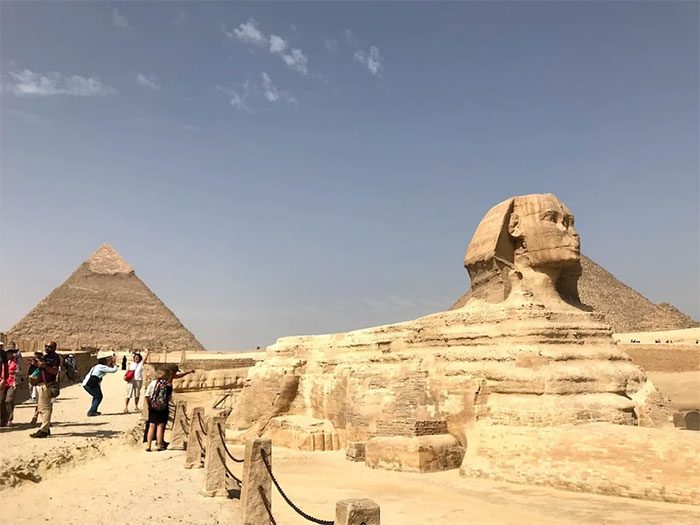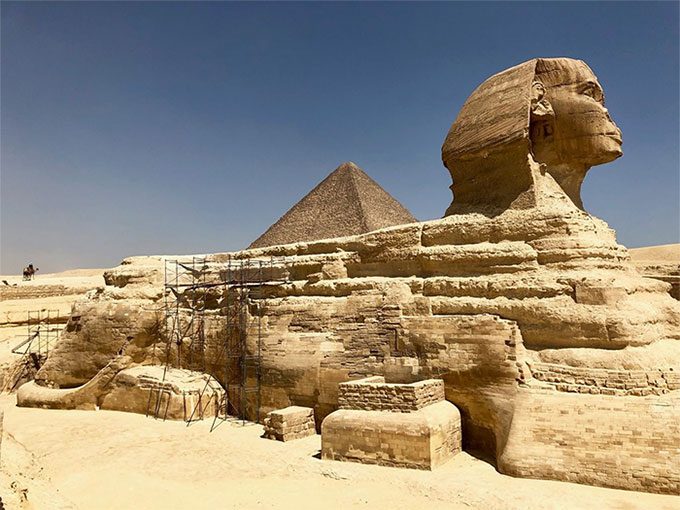Standing nearly 20 meters tall from the ground to the top of its head and measuring over 72 meters from its front paws to its tail, the Great Sphinx of Giza is one of the largest and oldest sculptures in the world.
With the body of a lion and the face of a pharaoh, the Great Sphinx has become an emblem of ancient Egypt, inspiring replicas around the globe, from Las Vegas, Nevada, to Lanzhou, China.
For thousands of years, this colossal statue has rested at the foot of the Pyramids of Giza. However, it spent a long time buried under desert sands, leading to its near-forgotten status…
The Riddle of the Sphinx

The Great Sphinx is located next to the Pyramids of Giza in Egypt. (Source: Vietnam+).
In ancient Greece, the Sphinx was a monster with the head of a woman, the body of a lion, and the wings of a bird, known for killing anyone who could not answer its riddle.
In contrast, the Egyptian conception of the Sphinx depicted it as a benevolent creature, a guardian of the Pharaohs and the land of Egypt.
Unlike the Greek monster, the Great Sphinx has a human head and lacks wings. Various representations of the Sphinx appeared during different eras of ancient Egypt, while its lion body remained unchanged; however, the head changed forms, including that of a ram, a jackal, a hawk, and a crocodile.
Who Built the Sphinx?
Two of the greatest mysteries surrounding the Sphinx of Giza are when it was built and who constructed it.
Scholars agree that the Sphinx was built approximately 4,500 years ago, during the time of the ancient Egyptian kingdom when the great pyramids were erected.
Archaeologists believe the Great Sphinx was constructed during the Old Kingdom of Egypt (around 2575-2150 BCE) by Pharaoh Khafre of the Fourth Dynasty.
The Sphinx and these massive tombs are undoubtedly interconnected, as the colossal guardian seems to sit directly between the two Pyramids, each erected by different Pharaohs.
Khufu, who reigned around 2500 BCE, built the Great Pyramid, while his son Khafre constructed a slightly smaller tomb for himself.
As grand as the pyramids, information about these Pharaohs is sparse. Archaeologists have struggled to unravel the mystery of who built the Sphinx.
To date, there is no clear evidence of Khufu’s or Khafre’s contributions to the Sphinx’s construction.
The most popular hypothesis, proposed by Egyptologists like Mark Lehner and Zahi Hawass, suggests that Khafre built the Sphinx as part of his monumental projects, which included his own tomb and surrounding temple complex.
These scholars have studied various structures within the Pharaohs’ necropolis and found that the Sphinx’s location aligns best with Khafre’s pyramid and temples, indicating that these constructions were carefully and logically planned.
Researchers believe the Sphinx itself was carved from a massive limestone bedrock that was likely exposed as workers quarried large stones for the nearby temples.
In ancient Egypt, the Sphinx was revered and considered part of the sacred Giza necropolis.
Rebirth from the Sand
Over time, however, the statue was forgotten, buried by desert sands until only the head of the Sphinx remained visible.

The Great Sphinx has been partially eroded by time. (Source: Flickr)
In the late 1790s, as Napoleon’s army fought the British in Egypt, the French emperor became fascinated by ancient Egyptian history and its monuments, including the Sphinx.
Upon seeing the statue and the pyramids, Emperor Napoleon exclaimed, “Thousands of years of history are mocking us!”
The allure of ancient Egypt inspired Napoleon’s followers so much that upon returning to France, they embarked on creating a diverse historical archive of ancient Egypt with detailed drawings of everything they witnessed in the country.
Subsequent excavations of the Sphinx began, but all efforts by archaeologists met with little success.
It wasn’t until 1817 that Italian Egyptologist Giovanni Battista Caviglia began to achieve success, and by the late 19th century, the Sphinx’s broad chest and massive feet were finally visible.
Ultimately, the very desert sands—the “criminal” that buried the Sphinx—”atoned” and revealed the statue once more. By the late 1930s, a sandstorm swept away all the sand, and the Sphinx was fully exposed.
This re-emergence after centuries of being buried under sand surprised and astonished humanity due to its colossal size: nearly 20 meters tall from the ground to the top of its head and over 72 meters long from its front paws to its tail.
This makes it one of the tallest and oldest sculptures in the world, with the majority of the Sphinx carved directly from a massive limestone block.
The head of the Sphinx carries several symbols of the ancient Egyptian monarchy. The Sphinx wears the cloth headdress of the Egyptian Pharaohs and is carved with a cobra on its forehead.
Time has robbed the Sphinx of its nose and noble beard, but the remaining features remain clearly identifiable despite the erosion.





















































